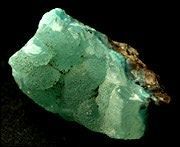One of the longest nerves in the body is known as the vagus nerve (VN). The VN is the 10th pair of cranial nerves that originates at the brain stem in the medulla oblongata. This nerve is part of the parasympathetic nervous system, which is a part of the ANS. Research suggests ear acupuncture can activate the VN.
Herbs & Botanicals
Smithsonite (lu gan shi)
What is smithsonite? What is it used for?
Also known as calamine, smithsonite is not an herb, but a type of mineral derived from zinc. In the United States, is reportedly named after James Smithson, who founded the Smithsonian Institution.
It is somewhat brittle and ranges in color from whitish-yellow to grey, or even light red, and has a silky luster that resembles melted wax. It usually has an uneven surface, with small pores. In China, it is mined primarily in the Guangxi, Sichuan and Hunan provinces. According to the principles of traditional Chinese medicine, smithsonite has sweet and neutral properties, and is associated with the Liver and Stomach meridians. Its main active ingredients are zinc carbonate and various oxides, including magnesium oxide, manganese oxide, zinc oxide and calcium oxide. Smithsonite is used to treat a wide range of conditions related to the eyes and skin, including swollen eyes, eczema, itchy skin, skin ulcers, and sores under and around the eyelids.
According to the principles of traditional Chinese medicine, smithsonite has sweet and neutral properties, and is associated with the Liver and Stomach meridians. Its main active ingredients are zinc carbonate and various oxides, including magnesium oxide, manganese oxide, zinc oxide and calcium oxide. Smithsonite is used to treat a wide range of conditions related to the eyes and skin, including swollen eyes, eczema, itchy skin, skin ulcers, and sores under and around the eyelids.
How much smithsonite should I take?
Smithsonite is only used externally. The exact amount of smithsonite to be used depends to a large degree on the condition being treated.
What forms of smithsonite are available?
Large chunks of smithsonite can be mined and may be found in mineral stores, as well as some Asian markets and herbal shops. Powdered smithsonite may also be available; it is often applied to the skin as a type of poultice.
What can happen if I take too much smithsonite? Are there any interactions I should be aware of? What precautions should I take?
Because smithsonite is a mineral and not an herb, its safety has yet to be evaluated by many leading herbal medicine organizations. Because of its chemical properties, however, smithsonite should be used only for external applications, and should not be taken internally.
As of this writing, there are no known drug interactions associated with smithsonite. As always, make sure to consult with a licensed health care provider before taking smithsonite or any other herbal remedy or dietary supplement.
References
- Barthelmy D. Mineralogy Database, 18998-2000. Smithsonite. Available online.
- Belanger C. Chinese Herb Selection Guide. Taos, NM: Redwing Books, 1997, p 842.
- Klein C, Hurlbut CS Jr. 1993. Manual of Mineralogy, revised 21st edition. New York: John Wiley & Sons, 1993.
- Xu JM, Wang ZZ. The treatment of 96 cases of bedsores with sheng ji san (engender flesh powder). He Han Zhong Yi (He Nan Chinese Medicine) 1993;9:230.
- Zhao CL, Lin B. The treatment of 62 cases of perianal eczematous itching with self-composed formulas. Ji Lin Zhong Yi Yo (Ji Lin Chinese Medicine & Medicinals) 1993;4:26.


